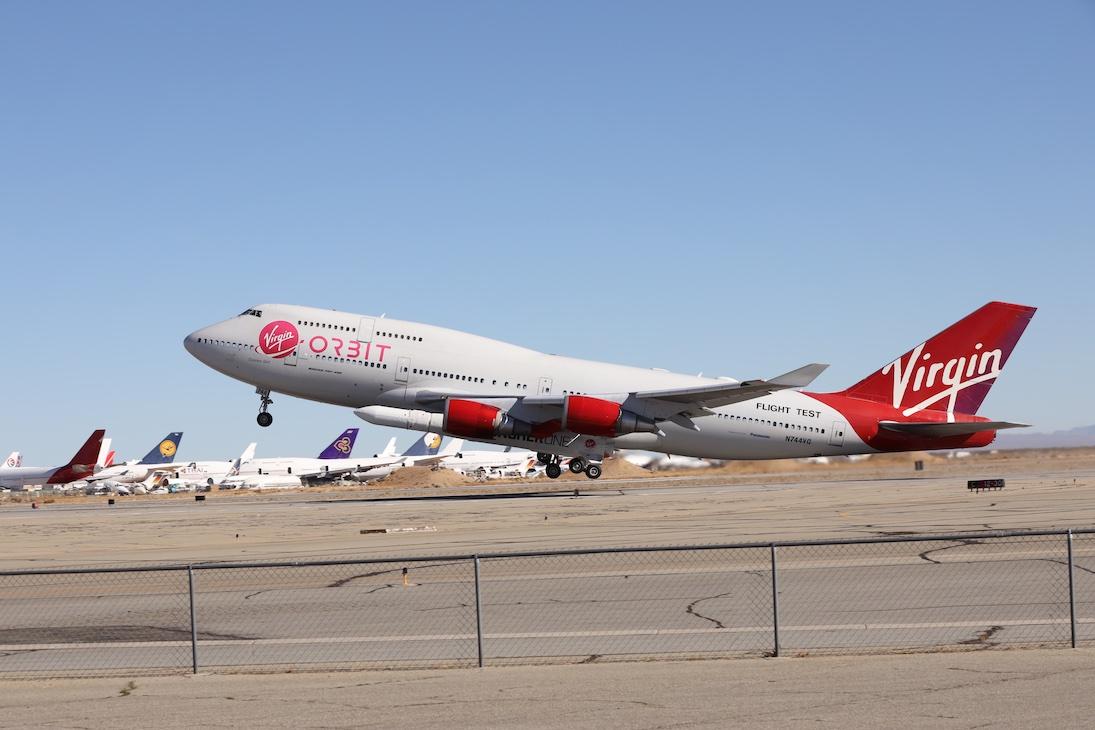
Virgin Orbit’s LauncherOne rocket successfully reached space for the first time on Jan. 17, carrying 10 small satellites to orbit and marking a key milestone for the privately developed, air-launched system.
The two-stage, liquid-fueled LauncherOne powered into polar orbit at 11.39 a.m. Pacific time after dropping from the left wing of Virgin Orbit’s Boeing 747-400 carrier aircraft at around 35,000 ft. off the coast of South California. Nominal orbital insertion was achieved after a 3-min. burn of the first-stage NewtonThree (N3) engine and an approximately 6-min. burn of the second-stage NewtonFour (N4).
The 747 deployed the rocket during a zoom climb maneuver in which it reached a flightpath angle of around 25 deg. Following release of the LauncherOne, the 747, flown by Virgin Orbit Chief Test Pilot Kelly Latimer, banked sharply away to the southwest and reached a peak altitude of around 38,000 ft. The carrier aircraft, which was accompanied by a Canadair CF-5D chase aircraft, then returned to its base at Mojave Air & Space Port in California, where it landed after a 1-hr. 44-min. flight.
The flight was Virgin Orbit’s second attempt to reach orbit with the LauncherOne following the loss of the first demonstration test flight on May 25, 2020. This was caused by a rupture of an oxidizer feed line, which led to significant strengthening of engine system components for the second flight, dubbed Launch Demo 2. The second mission carried a payload comprising several CubeSat missions contracted under NASA’s Venture Class Launch Services program, all of which were targeted to be deployed into a 310-mi.-high polar orbit after the N4 had relit for 5 sec. to circularize the trajectory.
Around 2 hr. after launch, Virgin Orbit still was working to confirm if the payloads had been deployed successfully. “We can confirm our NewtonFour upper stage engine successfully relit at the right time and for the right duration,” the company said in a statement on Twitter. “The payload separation command was issued as planned. The team is going through the data now to confirm everything—but it’s very encouraging.”
The 10 smallsats weighed in at around 253 lb., well below the LauncherOne’s design limit of 661 lb. for a standard polar orbit. The rocket also can deliver up to 1,100 lb. of payload to a low-altitude equatorial orbit, says Virgin Orbit, which aims to become the second privately funded company after U.S.-New Zealand-based Rocket Lab to provide smallsat launch capability. Developed as part of a $4.7 million NASA contract from 2015, the research satellites in the Launch Demo 2 payload are designed for a wide variety of research projects, ranging from tracking space debris to space weather.
The 10 individual CubeSats were built by the University of Colorado, Boulder; University of Michigan, Ann Arbor; Capitol Technology University in Laurel, Maryland; University of Central Florida in Orlando; Vanderbilt University in Nashville, Tennessee; California Polytechnic University in San Luis Obispo; University of Louisiana at Lafayette; Brigham Young University in Provo, Utah; New Mexico State University in Las Cruces; and by NASA’s Ames Research Center in Moffett Field, California.





